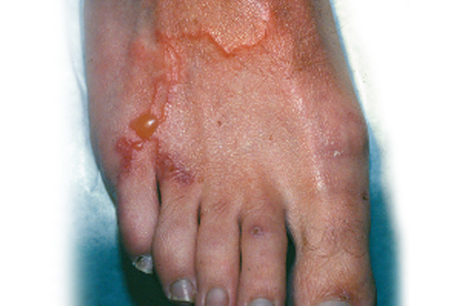History and exam
Key diagnostic factors
common
recent travel to tropics or subtropics
barefoot beachgoer/sunbather
For tourists visiting beach destinations in the tropics, walking to or on a beach without shoes or sandals has been identified as one of the strongest risk factors for developing CLM.[3] Furthermore, lying on a towel placed directly on the sand while sunbathing also carries a risk because lesions can occur on any unprotected part of the body.
creeping, raised, erythematous track
The characteristic lesion is serpiginous or linear, usually a few millimeters wide, a few centimeters long, and advances by a few millimeters to a few centimeters daily.[29][Figure caption and citation for the preceding image starts]: Typical appearance of cutaneous larva migransFrom the collection of Dr Gregory L. Zalar; used with permission [Citation ends].
Larval tracks may be single or multiple, and are located most commonly on the feet, thighs, and buttocks, related to the most common areas to come into contact with contaminated soil.[4][6] However, lesions can occur on any unprotected part of the body, including hands, arms, trunk, scalp, face, breasts, and genitals.[32]
Other diagnostic factors
common
uncommon
folliculitis
Rarely, a returning traveler may present with folliculitis due to creeping larvae becoming trapped in the sebaceous follicular canal. In such cases, pruritic papules and pustules are found in association with relatively short tracks, primarily on the buttocks.[5]
Risk factors
strong
recent travel to or residence in an endemic area
Most cases of CLM in the developed world are reported in tourists who have recently visited the tropics, especially beach destinations in the Caribbean, Southeast Asia, South America, and Africa.[3][4][21][23][24][25] CLM is common in areas where stray dogs and cats are permitted to freely defecate outside such as on beaches or in rural areas.
In endemic areas, most cases occur among children, especially those of low socioeconomic status and those who frequently walk barefoot.[18]
Risk is further increased during the rainy season in these areas because embryonated eggs and larvae survive longer in wet than in dry soil.[12]
walking barefoot and/or sunbathing on contaminated beach
For tourists visiting beach destinations in the tropics, walking to or on a beach without shoes or sandals has been identified as one of the strongest risk factors for developing CLM.[3] Furthermore, lying on a towel placed directly on the sand while sunbathing also carries a risk as lesions can occur on any unprotected part of the body.
Use of this content is subject to our disclaimer